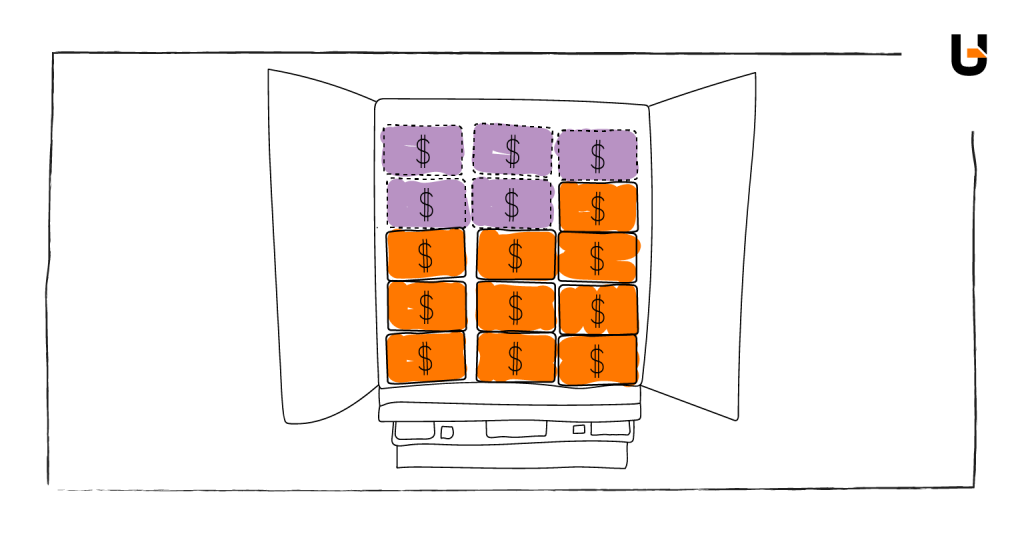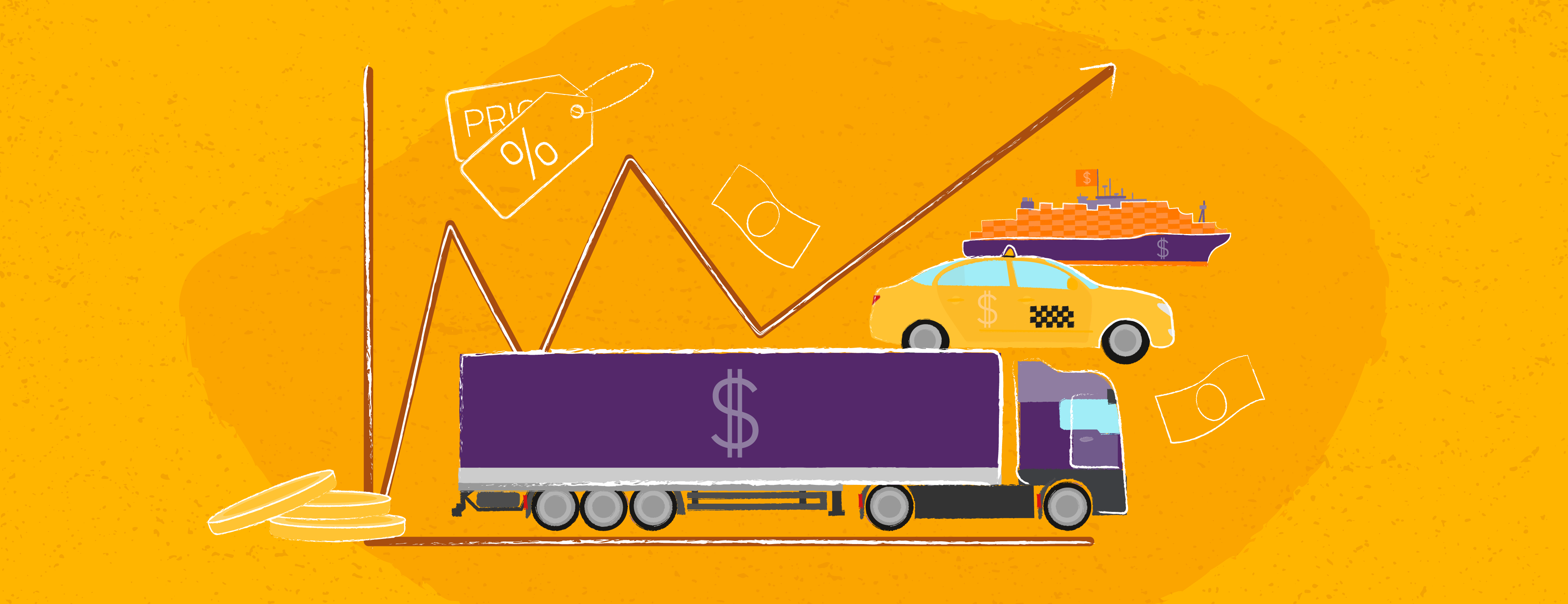Dynamic Pricing Strategy / The Game Changer You Can’t Miss in your Business
Within the article, you will find the following:
Dynamic Pricing in e-commerce and the role of artificial intelligence in business
A simple automation or an artificial man?
The way to create smart price wizards
Dynamic Pricing Behind the Scenes
Why is it worth implementing a Dynamic Pricing strategy in logistics?
How to build a transport company competing with smart pricing?
In the beginning there was dynamic pricing…
The history of pricing (dynamic pricing, actually) dates back to ancient times. Fixed prices are a relatively new phenomenon. The practice first appeared with the likes of gas engines, light bulbs, telephones or dynamite during the second industrial revolution in the nineteenth century. Previously, shopkeepers and traders used the strategy of dynamic prices, adapting them to the status of the customer in front of them and considering, their appearance or behavior, for example.
Interestingly, from the perspective of our times, it seems that setting the price on the basis of a client’s superficiality was an element of ennoblement and prestige for the those paying more.
Of course, history repeats itself and the history of pricing is no different. Today, we have the option of price optimization and dynamic pricing in e-commerce.
What is Dynamic Pricing?
A Dynamic Pricing strategy consists of setting flexible prices for products and services in terms of current market requirements. Organizations implementing a dynamic pricing strategy do so via machine learning algorithms that automatically and predictably change prices, taking into account a number of variable factors, e.g. demand, supply, competitors’ prices, availability, seasons and others.
We can see dynamic pricing examples in everyday life. They are commonly used by companies from the hotel, travel and logistics industries. In aviation and retail trade, it’s utilized by the biggest giants: Booking.com, Amazon and Uber – the latter of which makes the proposed price dependent on… the battery status of your phone!

Dynamic Pricing in e-commerce and the role of artificial intelligence in business
Around 150 years ago, prices had to be standardized due to a lack of qualified sellers. Fixed prices were the market’s response to a drastic increase in the amount of goods in market turnover.
Currently, with the rapidly developing e-commerce market, the closely related courier services market has gained an equally dynamic growth rate. Parallel to this phenomenon, progress in the area of digitalization and communication has significantly accelerated. As in the nineteenth century, there is once again a shortage of qualified specialists in the field of sales. By connecting all the dots, it is natural to seek help from artificial intelligence and machine learning solutions.
People have always strived to simplify their work. Automation frees you to focus on other elements of the capitalist game, e.g. the expansion of the offer or the market. Artificial intelligence can symbiotically coexist with humans, bringing great results. This is already happening. It can certainly be assumed that the sluggishness in the adaptation of AI in the management process in the long term will mean the loss of markets and, consequently, profits.
A simple automaton or an artificial man?
We should also emphasize that the price generator for the customer should ultimately not be just a simple machine. It is not an art to build something worse than a human being. Today, we have the ability to build something that, in a very narrow range, will many times exceed human intelligence.
Therefore, it is not about replacing man, but about building a system – consistent with the business strategy – that will reach a level of speed and depth of calculation unattainable for a person.
A misunderstanding regarding “artificial intelligence” is that the term defines a simple reception machine in a hotel or a voice portal of railway information. On the other hand, there are relatively simple mathematical algorithms in the application environment that are able to make difficult decisions. These decisions are usually much better than decisions that a human would potentially make. These are optimal decisions, i.e. the best possible option in the given conditions. That is why we humans cannot resist the impression that we are dealing with artificial intelligence, even though, in fact, they are only simple optimizers based on equally simple functions. In the future, the combination of hundreds of such algorithms will produce intelligent artificial beings.
The way to create smart price wizards
Progress is made gradually. We would like to believe that humans are still deciding how fast artificial intelligence algorithms are developing. In fact, it is not us, but economics, that dictate the pace of change. If a competitive transport company begins to push us out of the market by strangely accurate decisions and more efficient fleet management systems, we will have nothing else to do but intensify the development of our own price optimization systems. Evolution knows no mercy. Experts agree that, in the transport industry’s near future, we will see the dynamic development of two types of autonomous systems: dynamic price creators and transport process management systems.
Below you will find the basic methods regarding the dynamic formation of smart prices. Importantly, all these methods can be used in parallel.

Dynamic Pricing Behind the Scenes
Two-way rule system
Rule Based is the simplest and probably the most widespread system of creating prices, including prices for transport services. It is activated when the customer configures the scope of the transport order in terms of time, place, additional services and dimensions of the shipment. Further extras are added to the basic price of the flight ticket, such as a priority place in the queue, the possibility of adjusting some elements of the service or adding additional baggage. It is a simple system, adding more items from the programmed list. It is also a simple addition of costs for further, additional services. Such an option is based on rigid rules. Due to the low flexibility of this solution, this mechanism cannot respond to unforeseen changes occurring in the external environment.
Conditional rules
The disadvantage of systems based on rigid rules from a predefined list is their lack of reference to external factors. However, you can easily add conditional rules to the list of simple rules. The conditions may be our current transport capacity, market situation, weather or even the activities of competitive companies.
In the case of air ticket reservations, a conditional rules system could work with a seat management system. Let’s say we’ve introduced a conditional rule in the sale of cargo space in sea containers. If the cargo space is less than 50% occupied and the deadline for handing over the container is imminent, the conditional rules automaton may significantly reduce freight prices. This may be the average lowest price (the lowest mean in terms of the value from the range of the second deviation of the standard probability density distribution) of this or a similar charter from the last two months. The sales algorithm may offer a price, e.g., 20% lower than the prices for similar routes on the sea parcel exchange. Thus, depending on the situation in different areas of activity, the price offered will change. Let’s note how great economies of scale we will achieve by running this simple and relatively cheap tool. You can enter very complex rules, you can create conditions based on other conditions. When the occupancy of the cargo space of the semi-trailer reaches the level of 75%, the system will propose a price representing 110% of the average market price for the corresponding transport. This value will be a previously calculated threshold of customer sensitivity on a regular basis based on the history of thousands of other similar transactions. The price will therefore be constantly updated with market prices and other variables, the results of dynamic models, and rigid rules in relation to the situation in which the entrepreneur finds themself.
Dynamic pricing based on customer segmentation
It seems that the ‘old days’ (in the sense of trade) are somewhat returning. Today again, every ‘shopkeeper’ (read: e-commerce) can know each of his customers perfectly – their choices, frequency of shopping and their motivations. Today, too, each customer can have his or her pricing rules set by the seller.
It is worth noting that, so far in retail sales, every customer was and still is anonymous. But this is precisely what is different in online sales. There, each customer usually has their own login and ID number, alongside other parameters. Transactions made on the internet are recorded in the server registry, so that each client can be described and assigned to a specific group or separate cluster.
In order for this assignment to be possible, several important features need to be distinguished. Therefore, it is standard to distinguish from the transaction history the frequency with which the individual customer made transactions and their value. It is also important to determine how much time has passed since the customer’s last purchase. The described method is called RFM from the words: recency, frequency, monetary.
Classes can be further created from such separated descriptive variables. For example, for the monetary trait, three classes can be distinguished: spending a lot of money, spending on average, spending little money. Based on the recency, frequency, monetary classes, an algorithm of associative rules can be used. This algorithm will distinguish groups of customers by subclasses, e.g. they were here a long time ago – they spend a lot of money – they used to be frequent.
It’s like a recorded thought of a shopkeeper seeing his old customer. This time, however, this information is used as batch data to inform the algorithm making the decision.
In accordance with the chosen strategy and the threshold of customer sensitivity to price changes, the system can offer customers specific price discounts or an optimal marginal price.
Let’s schedule a free Dynamic Pricing consultation!
Key Performance Indicators (KPIs)
It is possible to compose prices based on predefined performance indicators. The management of the company can set certain limits to the price adjustment. Prices can be variables in equations calculating the level of profit, variable costs and what means of transport are used, if any. Performance indicators can be found in most transport companies. They set priorities and boundaries for action. They show the efficiency of the implementation of projects and processes. Nothing prevents KPIs from being introduced to intelligent price generators in the form of subsequent conditional variables.
Operational studies
In this method, it is necessary to define a number of limitations that occur in the process. Restrictions can include drivers’ working time, cargo space, loading time or the number of places through which the truck is to pass. These restrictions are called boundary conditions. In addition to limitations, it is necessary to define the function of the target. The goal may be, for example, to maximize the efficiency any transport equipment used, minimize costs or increase the number of customers. The operations research algorithm will propose one solution called the optimal solution. The price can be variable in this method to obtain the optimal solution. By reversing the equation, you can find the optimal price for the specified input parameters. Creating dynamic prices using the operations research method is one of the most advanced analytical methods and undoubtedly the most effective approach.
Prices based on demand elasticity
The price elasticity of a market is the sensitivity that market participants have to price changes. There are industries where demand is rigid. Sometimes, customers will buy a service regardless of its price, because it is necessary for business. An example is the repair of a truck required for operational use. Penalties for failure to meet the delivery date are much higher than the costs of ad hoc repair. At other times, due to the availability of services, prices are shaped in accordance with the principles of a perfectly competitive market, and customers are very sensitive to any changes. The sensitivity of market demand is a fundamental component of the dynamic price formation algorithm.
Market forecasts
To build a forecasting model, you need to have a historical dataset about market transactions. Let’s assume we are transporting ice cream in refrigerated semi-trailers. Ice cream is sold differently in the summer, and differently in the spring. The price for freight in refrigerated semi-trailers will vary depending on the demand and availability of specific products on the market. To shape prices intelligently and dynamically, you need to build price forecasts based on historical data. In this way, we will get prices in the future, before the factors that will shape them appear. This is what Machine Learning forecasting models are used for.
The sample model, after obtaining information from the weather forecast about the temperature and level, will determine the demand for transport in the future. In this way, it is possible to avoid the erroneous contracting of freight when it’s possible to earn much more on ‘free’ routes. In addition, these models can take into account a number of other variables, such as the activity of competitors, the location of warehouses, traffic jams and repairs on the roads, as well as the availability of drivers. In forecasting, tree models based on entropy (Random Forest Regressor and Reinforcement Regression Models) and regression models based on the conditional probability of Thomas Bayes (Naive Bayes For Regression) will work well. Models based on recursive neural networks can also be used for forecasting. Knowing future trends can be a huge competitive advantage.
Why is it worth implementing a Dynamic Pricing strategy in logistics?
Transport and logistics is one of the main industries in which optimization through a strategy of dynamic valuations is an excellent business approach. This need was particularly highlighted by the pandemic and the war in Ukraine, and with them their consequences, i.e. broken supply chains, and above all galloping inflation and high fuel prices. Above, we have presented several methods of dynamic smart pricing that can be successfully applied in the transport industry, facing the challenges that the business has been posed by the world for several years, while still generating measurable profits for the company.

As McKinsey reports in its analysis: “Logistics companies that change their prices can increase revenue by 2 to 4 percent, which will translate into up to 30 to 60 percent increase in operating profit” According to this report, the development strategy of transport companies based on dynamically shaped prices is the most profitable direction of potential development.
It is easy to see that similar trends have emerged in the relatively new online sales industry. Based on artificial intelligence algorithms, price optimization is an area of increasing competitive advantage. With constant sales prices, companies usually competed with each other, lowering margins and improving quality. This time, mathematical algorithms can find niches and places of rigid demand in order to achieve high margins from the sale of transport and accompanying services. Thus, we are not talking here about a simple reduction of your own margin or a rebate policy that, at the expense of losing a certain part of the profit, increases sales and builds the loyalty of contractors.
Intelligent systems that create prices for transport are primarily based on deep econometric, statistical and behavioral analyses. These prices will be increasingly based on information on market behavior and on their own technical and economic conditions. To be ready to compete in this area, you need to invest in analytical abilities and start working with learning algorithms. It is worth noting that, increasingly, the competitive struggle is moving from the technical area to the area of solutions in the field of information processing systems.
The principles of a perfectly competitive market have led to a situation in which most transport companies have similar vehicles and technical infrastructure, as well as a similar scope of transport concessions. It can be expected that gaining a competitive advantage based on differences in drivers’ earnings between different countries will end with the introduction of European Union integration regulations and intra-Community migration.
Competition based on drivers’ earnings also has a negative moral dimension. Transport companies are therefore looking for other areas where they could gain a market advantage.
Sounds interesting for your business? Let us know!
How to build a transport company competing with smart pricing?
Until recently, the transport environment was dominated by the belief that, in order to build an organization capable of creating intelligent freight sales prices, it was necessary to develop appropriate qualifications among sales employees, and then indicate the priorities and goals to them. Such conclusions can be found in the McKinsey report from 2018, which points to the need to create local pricing offices and standardize the process in order to better assess the market. The report also wrote about the need to direct organizational culture towards dynamic communication with customers.
Four years have passed since the publication of this report. These were the years of the COVID-19 pandemic, war and political upheavals, the impending fuel crisis and the global recession. Today, the conclusions of this report seem to be very incongruous with reality.
Of course, the postulate of gaining a competitive advantage through dynamic price formation and by implementing new organizational solutions is still valid. What the report did not predict is the replacement of people by artificial intelligence systems.
Summary: Basic factors for the use of the Dynamic Pricing strategy in a transport company /BRIEF SUMMARY/
Strategic Dynamic Pricing:
- Maximizes the use of the fleet
- Minimizes fuel consumption
- Maximizes the use of human resources
- Increases the level of cargo space utilized
- Reduces the cost of a tonne-kilometer
- Reduces the average cost of a tonne-kilometer per raw material
- Streamlines business-to-business transactions
- Enables the preparation of optimal and e-stocked cars
- Helps to solve the traveling salesman's dilemma: it allows you to keep an optimal plan for connecting routes with shops. Prices can be adjusted for location, ensuring the final route’s stops are closely connected.
Summary
Effective price creation has always been a source of potential benefits. The merchant could please the customer. The buyer could listen to the seller. Mutual price setting was an important element of the transaction, strengthening customer loyalty and, above all, a source of additional profit for the store. This form of sales gave way to a massive, anonymous trade in goods and services at a fixed price. The increase in the share of online sales and the dynamic development of Data Science enables a return to active and intelligent price offering. According to the reports of leading consulting companies, the strategy of dynamic price formation will be the main source of competitive advantage in the transport industry in the future.







